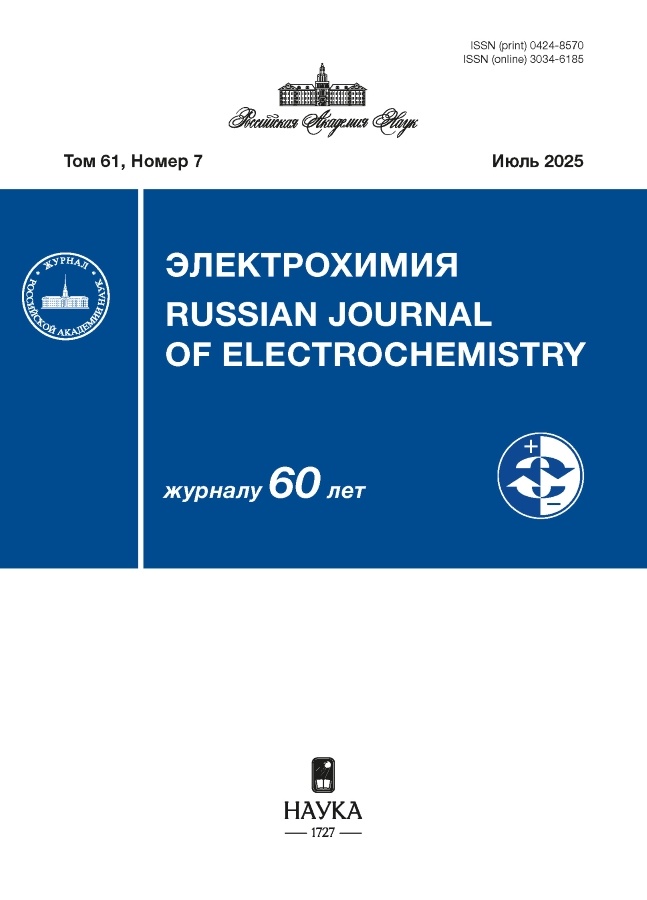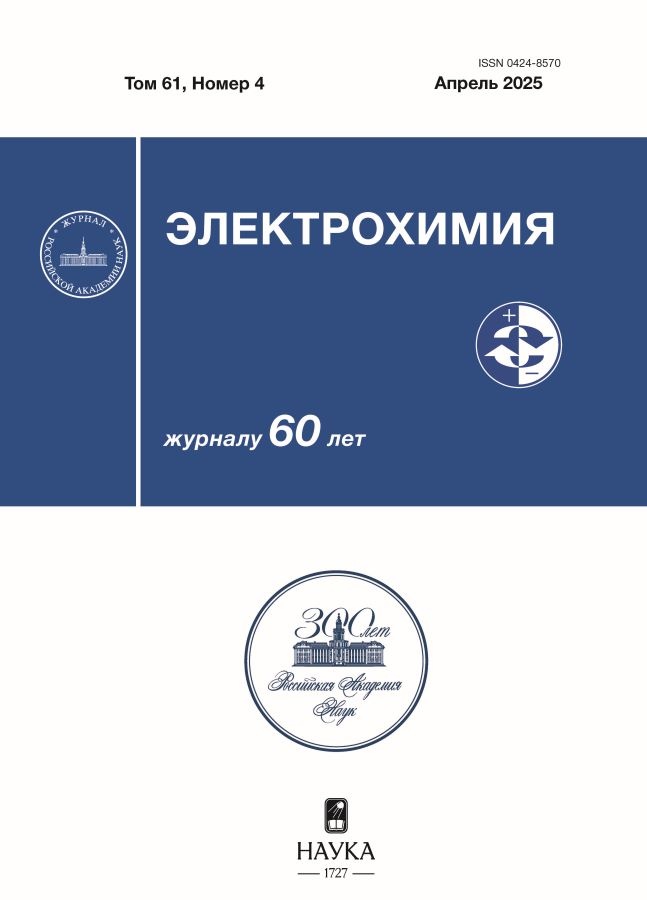Влияние уксусной кислоты на стойкость к локальной коррозии стали с 13% хрома в CO₂-содержащих средах
- Авторы: Пышминцев И.Ю.1, Мансурова Е.Р.1, Мальцева А.Н.1, Вавилова О.В.1, Костева С.А.1, Котов С.И.1, Котов С.И.1
-
Учреждения:
- ООО “Исследовательский Центр ТМК” (ООО “ИЦ ТМК”)
- Выпуск: Том 61, № 4 (2025)
- Страницы: 200-209
- Раздел: Статьи
- URL: https://rjmseer.com/0424-8570/article/view/685698
- DOI: https://doi.org/10.31857/S0424857025040017
- EDN: https://elibrary.ru/GBRIYK
- ID: 685698
Цитировать
Полный текст
Аннотация
Проведено исследование влияния концентрации уксусной кислоты от 0 до 5000 ppm на процессы возникновения и развития питтинговой коррозии нержавеющей стали мартенситного класса с 13% хрома в 5 мас. %-ном растворе хлорида натрия, насыщенном CO₂, при различных температурах, с использованием электрохимических методов, включая циклическую потенциодинамическую поляризацию и импульсный потенциостатический метод. Показано, что наличие уксусной кислоты в растворе стимулирует образование и развитие локальной коррозии, увеличивает скорость растворения металла внутри питтингов, способствует зарождению большего числа питтингов, их распространению по поверхности и срастанию.
Полный текст
Об авторах
И. Ю. Пышминцев
ООО “Исследовательский Центр ТМК” (ООО “ИЦ ТМК”)
Email: o.vavilova@tmk-group.com
Россия, Москва
Е. Р. Мансурова
ООО “Исследовательский Центр ТМК” (ООО “ИЦ ТМК”)
Автор, ответственный за переписку.
Email: e.mansurova@tmk-group.com
Россия, Москва
А. Н. Мальцева
ООО “Исследовательский Центр ТМК” (ООО “ИЦ ТМК”)
Email: o.vavilova@tmk-group.com
Россия, Москва
О. В. Вавилова
ООО “Исследовательский Центр ТМК” (ООО “ИЦ ТМК”)
Email: o.vavilova@tmk-group.com
Россия, Москва
С. А. Костева
ООО “Исследовательский Центр ТМК” (ООО “ИЦ ТМК”)
Email: o.vavilova@tmk-group.com
Россия, Москва
С. И. Котов
ООО “Исследовательский Центр ТМК” (ООО “ИЦ ТМК”)
Email: o.vavilova@tmk-group.com
Россия, Москва
С. И. Котов
ООО “Исследовательский Центр ТМК” (ООО “ИЦ ТМК”)
Email: o.vavilova@tmk-group.com
Россия, Москва
Список литературы
- Zhang, H., Zhao, Y.L., and Jiang, Z.D., Effects of temperature on the corrosion behavior of 13Cr martensitic stainless steel during exposure to CO₂ and Cl– environment, Mater. Lett., 2005, vol. 59, p. 3370.
- Dalmau, A. and Richard, C., Degradation mechanisms in martensitic stainless steels: Wear, corrosion and tribocorrosion appraisal, Tribol. Int. J., 2018, vol. 121, p. 167.
- Du, J., Xiang, K., Zhao, L., Lan, X., Liu, P., and Liu, Y., Corrosion inhibition of 13Cr stainless steel in HCl/HAc/HF acid solution, Int. J. Electrochem. Sci., 2019, vol. 14, no. 9, p. 8919.
- Пумпянский, Д.А., Пышминцев, И.Ю., Выдрин, А.В., Кузнецов, В.И., Красиков, А.В. Основы металловедения и технологии производства труб из коррозионно-стойких сталей. М.: Металлургиздат, 2023. 682 с. [Pumpyanskii, D.A., Pyshmintsev, I.Yu., Vydrin, A.V., Kuznetsov, V.I., and Krasikov, A.V., Fundamentals of Materials Science and Production Technology of Corrosion-Resistant Steel Pipes (in Russian). Moscow: Metallurgizdat, 2023. 682 p.]
- Мач, С., Бени, Х. Влияние температуры на локальную коррозию нержавеющей стали. Электрохимия. 2000. Т. 36. С. 1268. [Matsch, St. and Bohni, H., Influens of temperature in the localized corrosion of stainless steels, Russ. J. Eleсtrochem., 2000, vol. 36, p. 1122.]
- Yin, Z.F., Feng, Y.R., Zhao, W.Z., Yin, C.X., and Tian, W., Pitting corrosion behaviour of 316L stainless steel in chloride solution with acetic acid and CO₂, Corros. Eng. Sci. Technol., 2011, vol. 46, no. 1, p. 56.
- Al-Moubaraki, A.H. and Obot, I.B., Top of the line corrosion: causes, mechanisms, and mitigation using corrosion inhibitors, Arab. J. Chem., 2021, vol. 14, no. 5, p. 103116.
- Larrey, D. and Gunaltun, Y., Correlation of cases of top of line corrosion with calculated water condensation rates, NACE Corros., 2000, no. 71.
- ISO 21457:2010. Petroleum, petrochemical and natural gas industries – Materials selection and corrosion control for oil and gas production systems. 2010.
- NORSOK M-001. Material selection. 2014.
- Plennevaux, C., Cassagne, Th., Bonis, M., Ferrando, N., and Kittel, J., Improving pH prediction for high pressure and high temperature applications in oil and gas production, Corrosion, 2013.
- Sun, Y., George, K., and Nesic, S., The effect of Cl– and acetic acid on localized CO₂ corrosion in wet gas flow, NACE – Int. Corros. Conf. Ser., 2003, no. 03327.
- George, K., Nesic, S., and de Waard, C., Electrochemical investigation and modeling of carbon dioxide corrosion of carbon steel in the presence of acetic acid, Corrosion, 2004, no. 04059.
- Guo, X., Chen, Z., Liu, D., Bando, K., and Tomoe, Y., The effect of acetic acid and acetate on CO₂ corrosion of carbon steel, NACE – Int. Corros. Conf. Ser., 2005, no. 05306.
- Li, P., Du, M., Hou, J., Zhang, Y., Fan, L., and Lin, C., Corrosion behavior of 316l stainless steel in oilfield produced water in presence of CO₂ and acetic acid, Int. J. Electrochem. Sci., 2020, vol. 15, p. 4287.
- Hedges, B. and McVeigh, L., The role of acetate in CO₂ corrosion: The double whammy, NACE – Int. Corros. Conf. Ser., 1999, no. 21.
- Zhang, H., Huang, W., Wei, H., Chen, Z., Cao, J., Tang, Y., Zhao, X., and Zuo, Y., Effect of HAc on the metastable pitting corrosion of 304 SS in NaCl solution, Materials, 2022, no. 15(10):3618.
- Rao, V.S. and Singhal, L.K., Corrosion behavior of Cr–Mn–Ni stainless steel in acetic acid solution, Corrosion, 2010, vol. 66, no. 8, p. 085004.
- Tran P., Brown B., Nesic S. Investigation of the electrochemical mechanisms for acetic acid corrosion of mild steel, Corrosion, 2014, vol. 70, no. 3, p. 223.
- Пумпянский, Д.А., Пышминцев, И.Ю., Битюков, С.М., Гервасьев, М.А., Гусев, А.А. Особенности микроструктуры, фазового состава и возможности упрочнения нержавеющих сталей с 13–17% Cr. Известия вузов. Черная металлургия. 2022. Т. 65. № . 9. С. 644. [Pumpyanskii, D.A., Pyshmintsev, I.Yu., Bityukov, S.M., Gervas’ev, M.A., and Gusev, A.A., Features of microstructure, phase composition and strengthening capability of stainless steels with 13–17% Cr, Izvestiya. Ferrous Metallurgy, 2022, vol. 65, no. 9, p. 644.]
- ASTM G61–1986 (R2018). Standard test method for conducting cyclic potentiodynamic polarization measurements for localized corrosion susceptibility of iron-, nickel-, or cobalt-based alloys.
- Esmailzadeh, S., Aliofkhazraei, M., and Sarlak, H., Interpretation of cyclic potentiodynamic polarization test results for study of corrosion behavior of metals: A review, Prot. Met. Phys. Chem. Surfaces, 2018, vol. 54, no. 5, p. 976.
- Davydov, A.D., Shaldaev, V.S., and Engel, G.R., Pitting on the 20Kh13 steel in chloride solutions, Russ. J. Eleсtrochem., 2006, vol. 42, p. 121.
- Lei, X., Feng, Y., Zhang, J., Fu, A., Yin, C., and Macdonald, D.D., Impact of reversed austenite on the pitting corrosion behavior of super 13Cr martensitic stainless steel, Electrochim. Acta, 2016, vol. 191, p. 640.
- Gao, J., Jiang, Y., Deng, B., Ge, Z., and Li, J., Determination of pitting initiation of duplex stainless steel using potentiostatic pulse technique, Electrochim. Acta, 2010, vol. 55, no. 17, p. 4837.
- Chen, B., Sun, Y., Cai, D., Yao, Q., Yin, L., Wan, Y., Jiang, Y., and Li, J., Use of the potentiostatic pulse technique to study and influence pitting behavior of 317L stainless steel, J. Electrochem. Soc., 2020, vol. 167, no. 4, p. 041509.
- Sun, Y., Sun, L., Dai, N., Liu, Y., Wu, J., Li, J., and Jiang, Y., Application of potentiostatic pulse technique and statistical analysis in evaluating pitting resistance of aged 317L stainless steel, Mater. Corros., 2020, vol. 71, no. 6, p. 900.
- Chen, S., Sun, L., Cao, W., Zhao, T., Qiu, J., and Li, W., Research on the pitting behavior of high nitrogen austenitic stainless steel 316LN in sodium chloride solution by using modified potentiostatic pulse test, J. Electroanal. Chem., 2022, vol. 922.
- Racot, A., Aubert, I., Touzet, M., Thiebaut, S., and Demesy, M., Statistical analysis of the pitting corrosion induced by potentiostatic pulse tests of wrought and SLM 316L stainless steels, Corros. Sci., 2020, vol. 197.
- Shao, Z., Yu, D., Shao, D., Du, Y., Zheng, D., Qiu, Z., and Wu, B., A protective role of Cl– ion in corrosion of stainless steel, Corros. Sci., 2024, vol. 226, p. 111631.
- Yin, Z.F., Zhao, W.Z., Lai, W.Y., and Zhao, X.H., Electrochemical behaviour of Ni-base alloys exposed under oil/gas field environments, Corros. Sci., 2009, vol. 51, no. 8, p. 1702.
- Tang, Y., Zuo, Y., Wang, J., Zhao, X., Niu, B., and Lin, B., The metastable pitting potential and its relation to the pitting potential for four materials in chloride solutions, Corros. Sci., 2013, vol. 80, p. 111.
- Lu, P., Zhang, P., Feng, H., Li, H., and Zhang, S., Revealing the impact of inclusion types on pitting corrosion behavior of high-nitrogen stainless bearing steels with different Ce contents: Induction effect of oxides/sulfides and inhibition effect of nitrides, Corros. Sci., 2024, vol. 236, p. 112247.
- Wang, X., Luo, H., Zhao, Q., Cheng, H.H., Li, Q., Pan, Z., Wei, Y., Ma, Y., and Li, X., Investigations on the passive and pitting behaviors of 17–4 PH martensitic stainless steel containing Al2O3 inclusions in chlorine environment, Colloids Surfaces A Physicochem. Eng. Asp., 2022, vol. 660.
- Li, T., Wu, J., and Frankel, G.S., Localized corrosion: Passive film breakdown vs. Pit growth stability, Part VI: Pit dissolution kinetics of different alloys and a model for pitting and repassivation potentials, Corros. Sci., 2021, vol. 182, p. 109277.
- Crolet, J.-L., Thevenot, N., and Dugstad, A., Role of free acetic acid on the CO₂ corrosion of steels, NACE Corosion, 1999, no. 24.
- Kahyarian, A., Schumaker, A., Brown, B., and Nesic, S., Acidic corrosion of mild steel in the presence of acetic acid: Mechanism and prediction, Electrochim. Acta, 2017, vol. 258, p. 639.
- Nesic, S., Kahyarian, A., and Choi, Y.S., Implementation of a comprehensive mechanistic prediction model of mild steel corrosion in multiphase oil and gas pipelines, Corrosion, 2019, vol. 75, no. 3, p. 274.
- Amri, J., Gulbrandsen, E., and Nogueira, R.P., Propagation and arrest of localized attacks in carbon dioxide corrosion of carbon steel in the presence of acetic acid, Corrosion, 2018, vol. 66, no. 3, p. 035001.
- Wei, J. and Zhou, B., Effect of acetic acid on the pitting corrosion of 2Cr12MoV turbine steel in early condensates containing chloride ions, Int. J. Electrochem. Sci., 2017, vol. 12, no. 4, p. 3166.
- Amri, J., Gulbrandsen, E., and Nogueira, R.P., Pit growth and stifling on carbon steel in CO₂-containing media in the presence of HAc, Electrochim. Acta, 2009, vol. 54, no. 28, p. 7338.
- Amri, J., On growth and stifling of localized corrosion attacks in CO₂ and acetic acid environments: Application to the top-of-line corrosion of wet gas pipelines operated in stratified flow regime, HAL, 2009.
- Amri, J., Gulbrandsen, E., and Nogueira, R.P., The effect of acetic acid on the pit propagation in CO₂ corrosion of carbon steel, Electrochem. commun., 2008, vol. 10, no. 2, p. 200.
- Wang, Y., Cheng, G., Wu, W., Qiao, Q., Li, Y., and Li, X., Applied surface science effect of pH and chloride on the micro-mechanism of pitting corrosion for high strength pipeline steel in aerated NaCl solutions, Appl. Surf. Sci., 2015, vol. 349, p. 746.
- Tsutsumi, Y., Nishikata, A., and Tsuru, T., Pitting corrosion mechanism of Type 304 stainless steel under a droplet of chloride solutions, Corros. Sci., 2007, vol. 49, p. 1394.
Дополнительные файлы



















